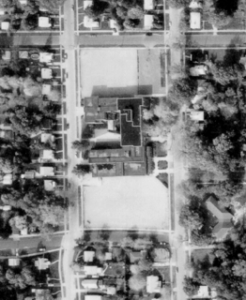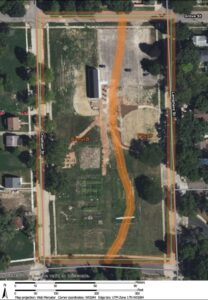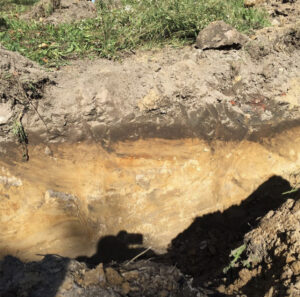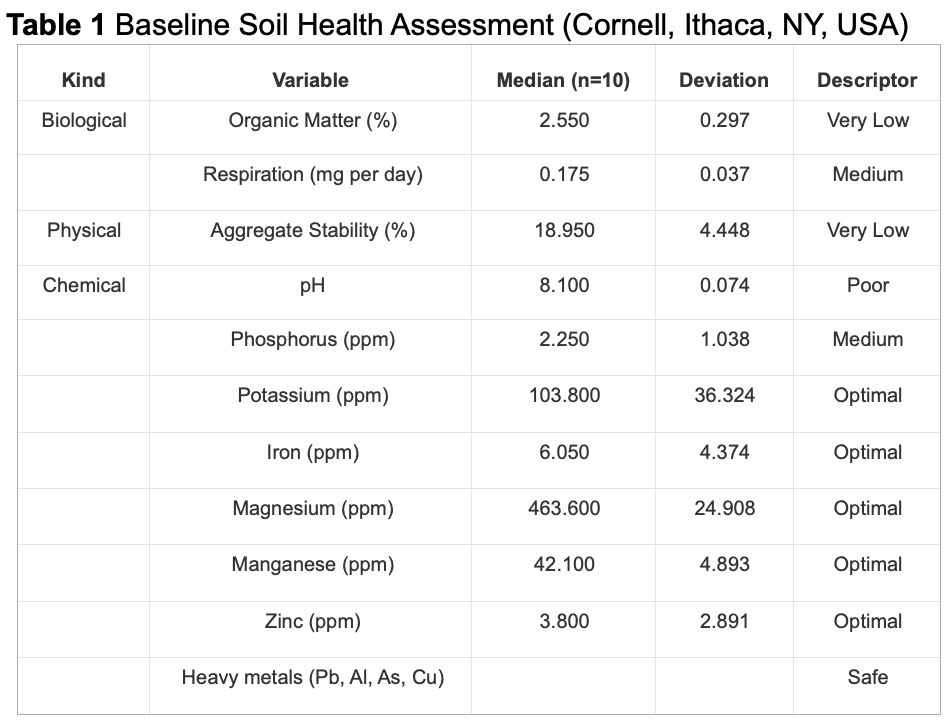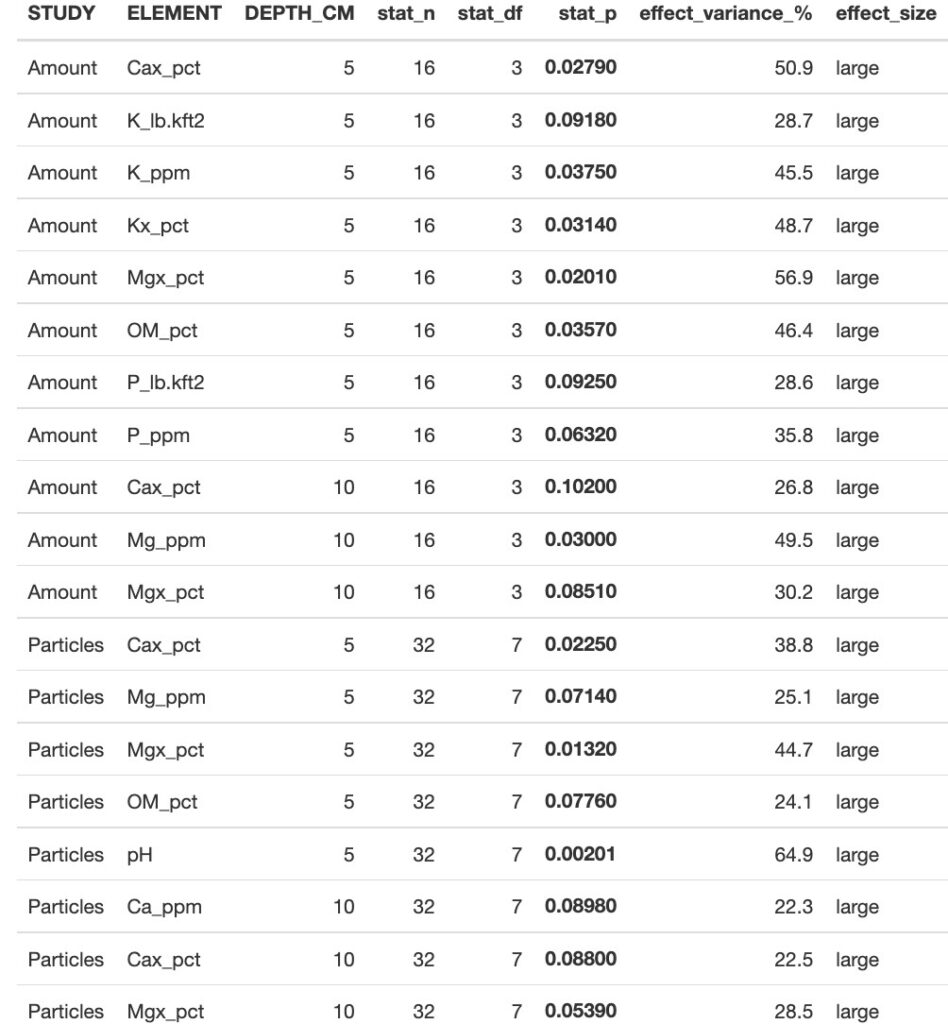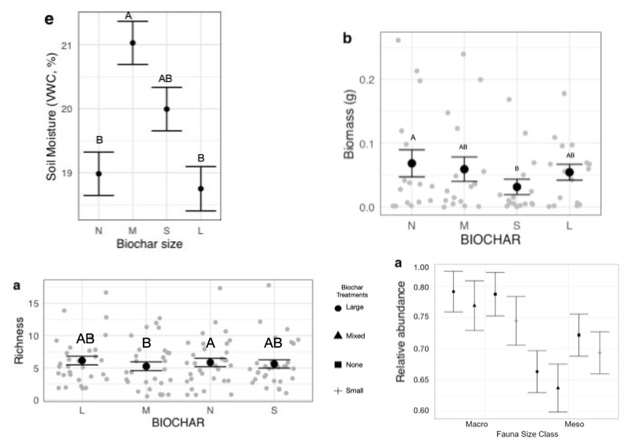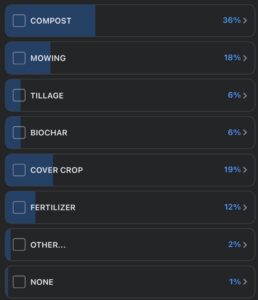Final report for GNC19-282
Project Information
Given that 81% of the US population lives in urban areas (2010 census), urban agriculture represents a key sector for increasing food security and improving quality of life for urban communities. However, urban soils often pose issues that limit agricultural productivity: including compaction (~50%), high pH (~8), and contamination with heavy metals (Lead, Arsenic) caused by hotspots of industrial activity and unregulated waste, often at concentrations definitively toxic to humans. This is especially true in Detroit, where, for example, 4 neighboring oil refineries have created the most polluted zip code in Michigan. As a result of uniquely severe soil issues like these, urban farmers, such as those in Detroit, often need to import topsoils and/or compost, which can be prohibitively costly, but is often the sole option for soil remediation due to city-level regulations on maximum urban compost pile sizes. Ultimately, importing organic soils does not represent an ideal nor feasible strategy for the sustainability of crop production by urban farmers. This project addresses urban soil compaction issues by evaluating the effects of biochar application, alongside legume mixtures, on soil structure, nutrient retention, soil biological activity, and plant growth. We found that biochar significantly lowers bulk density of fine-textured soils, improves organic matter and nutrient concentrations, holds more soil water, and affects soil invertebrate communities.
To complete this project, we engaged collaborative participation with several farmers, and analyzed soil responses related to soil structure, nutrient retention, and invertebrate community structure, and from this project produced scientific articles and seminar presentations about biochar's effects on (1) soil aggregation, structure, and theoretical background, (2) nutrient concentrations in an urban Technosol, (3) microbial community composition variation by biochar amendment treatment, and (4) invertebrate community composition and diversity in bulk soils.
Cooperators
- (Educator and Researcher)
- (Educator and Researcher)
- (Educator and Researcher)
Research
Study site
This study was done on a 50 x 50 ft area of the Michigan State University Extension Detroit Partnership for Food Learning and Innovation in the Brightmoor neighborhood of Detroit, MI, USA. The site lies approximately 2 mi from a river and the neighborhood contains a greenway collection of other small scale sustainable urban farms. This growing area had been minimally amended since the demolition of the former school on the property in 2017, keeping the soils in need of optimization for plant growth by amendment, rather than soil optimized for structural stability for construction. Baseline soil tests for the site show low levels of heavy metals (though nearby areas may have higher levels) and 2-3% organic matter, but high pH and low aggregate stability (Edwards, Medina, and Asker 2022).
Study design
Biochar particle size separation
Approximately one cubic yard (about 100 gal) of pine wood biochar (Wakefield Biochar, Columbia, MO, USA) was sieved manually at one mm (1000 µm) into two distinct particle size classes, small (<1 mm) and large (>1 mm), for two weeks. Sieved biochar was then mixed 1:1 by volume with compost (Tuthill Farms & Composting Inc, South Lyon, MI, USA) and let sit outside for two days to allow for some initial activating and inoculating processes.
Field prep
The study area tarp was removed and it was roto-tilled to 10 cm (4”) depth using a shared Brightmoor community roto-tiller (BCS 749).
The following season no-till was used and growth was stunted using a shared community weed whacker.
Plot layout
The study area was divided into a grid of 64 adjacent 15 x 15 cm (5 x 5 ft) using one foot wood chip and/or paper mulch pathways.
Biochar application
The biochar-compost mix was applied at 5% by volume of topsoil in the plot (5 x 5 ft x 5 cm depth) two days before seeding.
The following season one-quarter of the plots were maintained with repeat particle size treatments, and the other plots used for additional treatments. One-quarter was used for unmanipulated, biochar-only, compost-only, and (mixed-size) biochar-compost treatments. The remaining half was used to apply biochar at zero, five, ten, and 20% by volume, to test maximal potential soil responses.
Cover crop selection
Cowpea was chosen as a legume with bacterial-root symbioses that provide biological nitrogen fixation, adding soil nitrogen that biochar lacks, being a decay-resistant form of carbon, making a combination that studies show improves the effectiveness of biochar (urea is also an alternative nitrogen source). Cowpea also has African origins, making it of cultural importance to local Detroit urban farmers. Buckwheat was chosen as a companion crop for its ability to scavenge soil phosphorus, grow quickly, and attract pollinators via high floral density (SARE cover crop guide).
The following season an early cover crop mix of red clover and hairy vetch was planted to continue supplying nitrogen and root carbon to soils.
Planting
Seeds (Keep Growing Detroit, MI, USA; Johnny’s Selected Seeds, Albion, ME, USA) were planted by hand and planted into the soil using a hand hoe, arranged into two alternating rows of each species per plot at recommended distances apart (SARE cover crop guide) totaling eight buckwheat seeds and five cowpea seeds per row per plot (approximately 16 buckwheat and 10 cowpea seeds per plot).
The following season plots were seeded with beets and field peas in four alternating rows of eight to ten seeds each ~2.5 cm (1”) deep.
Data collection
Soil moisture
Field soil moisture was recorded within the top 5 cm in three microhabitats per plot two to three times per week for 12 weeks with a hygrometer followed by a handheld electric sensor (Vegetronix VG-METER-200). This frequency was chosen to help capture natural fluctuations in soil moisture, and use this temporal resolution to analyze how treatments potentially affected changes at the driest or wettest extremes, which is relevant for compacted fine-textured soils.
Soil sampling
Soil samples were collected in triplicate per plot using a 5.5 cm-wide metal corer and sand-filled dead-blow hammer for minimal disturbance (AMS Inc, American Falls, ID). Given early natural pedogenic profile development of this Technosol, each core sample down to 10 cm included both A horizon and some of that below it. To account for potential treatment effects of soil horizon or depth, each core sample was split along a natural horizontal fault line midway down, and treated separately throughout downstream analyses. A total of 192 soil core samples from 32 plots (n = 8) were collected in the Fall of the first year.
In the subsequent season, soils were collected in duplicate from 48 plots, in the same manner as before, after mowing the following Spring.
All soil samples were stored at 4 C within 24-72 h of collection.
Soil chemistry
To facilitate the soil mass requirements for multiple lab analyses, triplicate plot sub-samples were not pooled together. Instead, both depths of the first sub-sample from each plot, in every other row the first season (n = 4) and all rows the next season (124 samples total), were sent to the Michigan State University Soil and Plant Nutrient Laboratory (East Lansing, MI, USA) for a standard suite of garden soil analyses including 1:1 soil-water pH, extractable phosphorus (Olsen 1954), and ammonium-acetate extracted potassium (K), magnesium (Mg), and calcium (Ca). The second sub-sample from these same plots in every other row (n = 4, 32 samples total) were sent for only wet aggregate stability analysis to Cornell University Soil Health Lab (Ithaca, NY, USA). Lab chemical analyses were done for bulk soils rather than separate soil aggregate fractions due to soil mass requirements for lab protocols.
DNA extraction
Approximately 0.15 g soil was sub-sampled from each depth of the second of triplicate soil cores per plot in the first season, and from the second of duplicate soil cores per plot in the second season. These lab sub-samples were then run through the manufacturer protocol (PowerLyzer PowerSoil, QIAGEN, Ann Arbor, MI, USA), with some modifications including replacing half (300 µL) of recommended Powerbead solution with 1 M sodium-potassium phosphate buffer (pH 7), an additional water bath incubation at 65 C for 10 min, followed by a rapid freeze at -80 C for 5 min, to improve nucleic acid de-sorption from fine soil particles (noted in protocols.io). In total 160 DNA extractions were stored at -20 C and 16 batches checked for genomic DNA using BSA-added PCR before sending for sequencing.
Sequencing
Samples libraries were generated using primers for bacterial ribosomal v4 regions (Caporaso et al. 2011) and fungal ITS regions (Taylor et al. 2016) in standard PCR and troubleshooted with touchdown PCR, with final sequencing done on the MiSeq platform at the University of Michgan Microbiome Sequencing core (Ann Arbor, MI, USA).
Bioinformatics
DNA sequences were cleaned following the standard operating prodecures for using mothur (Schloss et al. 2009) on bacteria (https://mothur.org/wiki/miseq_sop/), which clusters sequence information with 97% similarity into OTU (genus) bins, and that for DADA2 (Callahan et al. 2016) on fungi (https://benjjneb.github.io/dada2/ITS_workflow.html), which clusters sequence information with 99% similarity into sub-species strain levels, and both treat rare singleton DNA sequences differently.
Aggregate isolation
Triplicate soil core samples were pooled per plot by depth and manually sieved to 2000, 500, 250, 125, and 63 µm at approximately 60 oscillations per two minutes with raw fraction masses recorded.
Invertebrates
Arthropods (i.e. insects and springtails and mites) were surveyed using one pitfall trap placed in the center of each plot. Traps were made of wide plastic cups with soapy water at the bottom, covered with propped paper plates to create cool shade while allowing crawlers to fall in by foraging. Traps were left outside for one week and then collected, sealed, and all trapped invertebrates transferred to smaller vials filled with 70% alcohol for preservation. Specimens were identified to Order and morpho-species under a microscope and abundance tallied by plot.
Plant biomass and pollination
Data on plant growth was collected throughout the season following grower recommendations including germination rate per species per plot. At the end of the season pods were collected from cowpea and all mature crops were cut at the stem base and equal number of individuals collected per species per plot in paper mulch bags, transported and oven dried at 65 C for approximately 48 h, and weighed.
Pollinator visitation surveys were also conducted on two days during the first season, along with data collected about buckwheat floral display, average number of flowers per inflorescence, number/proportion of flowers with fruit, and number/proportion of fruits with viable seeds inside.
Statistics
Field and lab data was recorded in Excel and analyzed in R programming language for statistical computing (R Core Team 2022). Data were centered at the plot level using medians and treatment effects decomposed separately by depth using relatively conservative non-parametric Kruskal-Wallis rank sum tests, with treatment level effect sizes estimated using the eta^2 calculation, which represents the proportion of variance in the response variable explained by the independent variable (i.e. plot treatments). Key open-source packages included here and dplyr for data cleaning, rstatix and vegan for statistical testing, and ggplot2 and ggpubr for plotting.
Soil bulk density
Overall, biochar amendments showed significant effects on and explained substantial variance in soil bulk density within the top 10 cm (~30-60%, Table, Figure). These effects were mediated by the amount applied, its particle size, and whether it was paired with compost. Here, the amount applied seemed to show the largest effects, with application at 5% of topsoil volume being better than none, but no added benefit at 10% until reaching 20% by volume topsoil, and no differing effect by topsoil depth. Biochar also showed an effect in addition to that of compost amendment; an effect that seemed to persist even when biochar was applied alone without compost in the top 5 cm. Particle size showed a noticeable effect as well, with small particles more strongly lowering bulk density, especially at 10 cm, and larger particles possibly increasing it.
These effects compared variably to our hypotheses. Increasing application amount lowering bulk density agreed with our hypothesis, while the effects of particle size and comparison with compost were surprising. Previous studies suggest that biochar primarily helps when co-applied with compost; however, it may be that this is not true specifically for the function of lowering bulk density, but is still true for other functions, like increasing nutrient fertility or potential yield. In this fine-textured soil, we thought large particles help counteract the consolidating effects of many fine soil particles. However, it may be that 1 mm biochar particles are too large to help work at the micron scales of sand and silt (0.02 mm), and that instead the particles here named Small are actually the more appropriate size to counteract collective soil particle behavior at these small scales.
These bulk density results suggest that small amounts of biochar can help transition post-construction urban soils for cultivation, in low-till systems. Biochar use was comparable to compost with respect to soil bulk density, so depending on costs, biochar might be a useful option, such as a more stable amendment that composes slower than compost does throughout the growing season.
For wet aggregate stability, biochar did not significantly explain its variation among analyzed samples (n=16). Changes in aggregate stability may occur over longer periods of time, or when overall soil structure has improved after sustainable cultivation over five years or more. Aggregate size fraction mass data may respond differently and is under analysis.
Soil chemistry
Biochar also had significant effects on and explained substantial variance across various soil nutrients within the top 10 cm of soil (~20-55%). In the top 5 cm, biochar amendment rates significantly increased organic matter, phosphorus, potassium, and percent magnesium and calcium saturation – with all nutrients showing similar response patterns as in bulk density, where 20% application is the highest and either 5% and/or 10% being intermediate. Particle size also appeared to have some effect on nutrients, with Mixed (unsieved) or Small sizes possibly increasing organic matter and available magnesium and its percent saturation. At 5-10 cm depth, however, intermediate application rates of 5 and 10% appeared to show slightly higher magnesium. On the other hand, particle size seemed to have more of an effect on calcium than magnesium.
These chemistry results suggest that biochar can work to increase nutrient fertility at the very top of soil in low-till systems, such as by accumulating microbial biomass and necromass along biochar surface area, but that nutrient dynamics slightly at depth become more nuanced, such as according to potentially different nutrient susceptibilities to leaching by dissolution and runoff. Accordingly, biochar may be more useful in improving basic soil physical and chemical properties, but not as much for micro-nutrient availability management.
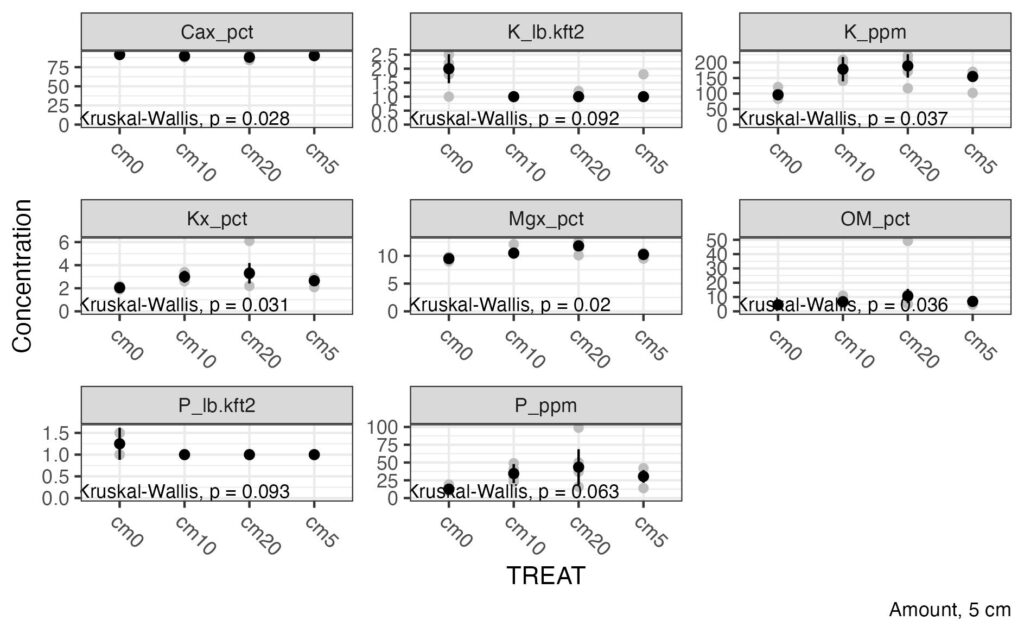
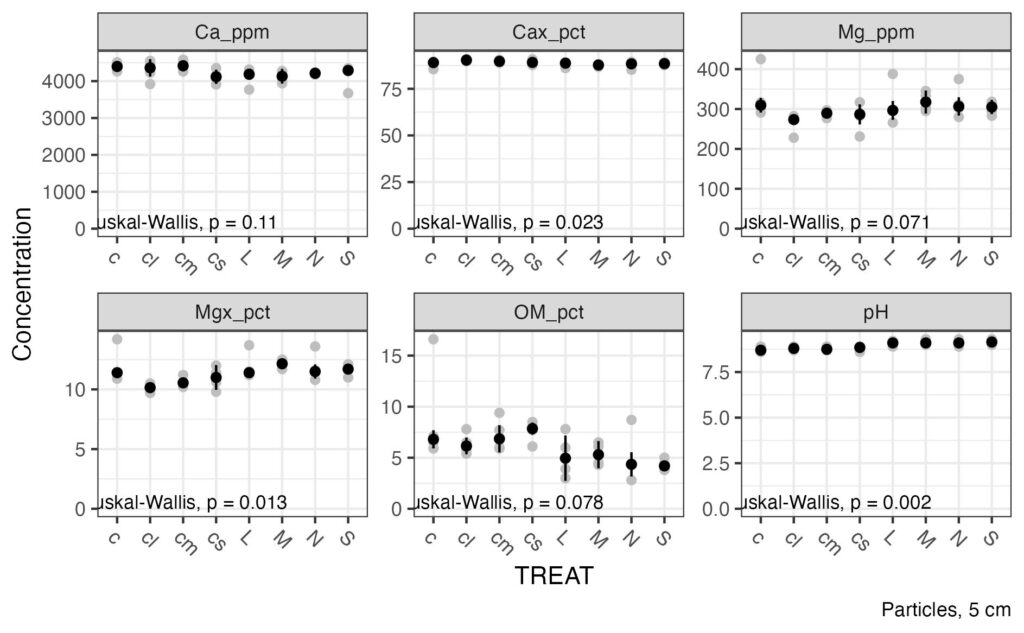
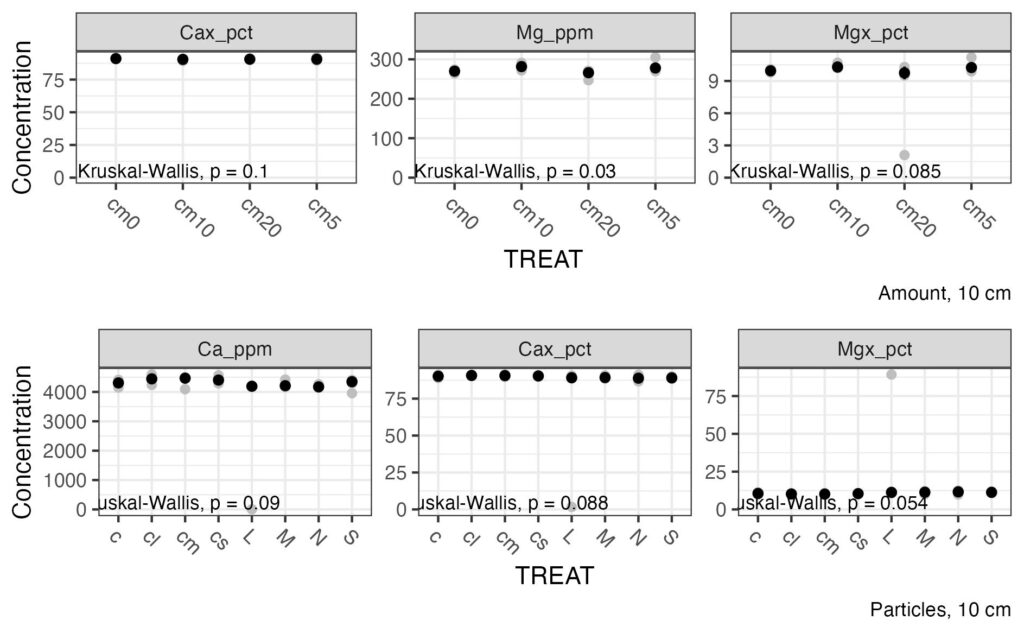 Bulk soil microbiome sequencing data are under analysis for diversity and taxon trends with findings in prep for a public pre-print article.
Bulk soil microbiome sequencing data are under analysis for diversity and taxon trends with findings in prep for a public pre-print article.
Soil invertebrates and moisture
Overall, biochar had a significant positive effect on average soil moisture and significant yet slight negative effects on invertebrate biomass and diversity, but no detectable response of other measured variables after the first 3 months.
Soil moisture was 2% higher in soils with unsieved biochar particles (Mixed, including those > 2 mm), and most of this effect appeared to come from the smallest (< 1 mm) particles (S). Larger (> 1 mm) biochar particles (L) appeared to perhaps reduce soil moisture on average, as hypothesized, but this was not detectable as statistically significantly different from control (None, N) plots, given natural variations among plots of the same treatment. Soil moisture in the subsequent season tended to appear different based on biochar treatment, with possible functional delineations at 1-2” depth. However, amended topsoils showed similar moisture levels across biochar application rate, particle size, and comparative compost treatments.
Soil invertebrate biomass was significantly lower in soils amended with small particles, and invertebrate diversity (alpha / richness) was significantly lower in the soils with unsieved (Mixed, standard) biochar applied. Though effects came from different treatments here, they make sense given that most of the effects, e.g. on moisture, appear to come from smaller particles (S, < 1 mm), which presumably have more surface area (biochar already has a lot) and uniform shape compared to larger particles (L, > 1 mm). The loss in invertebrate biomass and richness could be due specifically to fewer ground beetles, which have thicker exoskeletons, or using a bit more inference based on the results of a few other studies, due to negative effects of biochar on the reproductive rates of springtails, which are one of the most abundant groups of soil invertebrates, and a weaker effect of some relatively positive (i.e. less negative) biochar effects on younger invertebrate life forms due to more moist soil environments.
Average responses ± 1 std error to biochar treatments: None (N), Mixed/unsieved (M), Small (S, < 1 mm), and Large (L, > 1 mm). Meso and macro fauna were distinguished by taxonomic Order averaging below or above a 2 mm cutoff.
The effects of biochar found here may be slightly negative more directly on soil fauna, but the short-term positive effects on soil moisture may help save water for irrigation. The later benefits to crop growth and yield may be more variable as they depend on the the quantity and frequency of rainfall in the season, especially for soils with low organic matter. However, biochar application, which was of comparable cost to compost in this study and could be cheaper if sourced locally, could be an option to withstand variable rain and save money on irrigation, which can be expensive for home-owning urban growers in cities like Detroit.
Plant biomass
References
Educational & Outreach Activities
Participation Summary:
Overall, activity at this site was relatively high as new and burgeoning hub for urban agriculture. The experiences gained alongside this project owe much thanks to the following contributors to various activities at the site, in no particular order -- L'Oreal, Pamela, George, Jacki, Olivia, Kat, Devin, Detra, Stathis, Lauren, Lizzy, Mary, Detroit Hives, Kido, Keep Growing Detroit, initial consultants at MSU, and many other folks who've engaged to some degree with discussion or labor related to this project, including many others not on this list, plus the many visitors touring the site throughout the peak growing season.
Engagement was limited the initial year due to Michigan universities’ pandemic policies, but we participated in a promotional video for the site and connected with several interested neighbors and informally with some local growers on several days while gathering data, since the site is relatively new, and is aiming for acceptance by the most immediate neighbors of practice of the broader mission, which needs building after leasing of the site.
We also produced a short internal report about the project, connected with local agricultural non-profits, and made slides as part of a resulting thesis presentation.
https://www.youtube.com/watch?v=fpFBjVhkQPo (see description for credits)
Masters Practicum Presentation1 P1. Masters Practicum Presentation1 P2
Project Outcomes
Improving urban soil health is still likely to benefit urban growers. While biochar may still likely be an external input, it should be most sustainable when made or purchased from wood as local as possible, and mixed with compost and a legume crop so as not to bind and make nutrients less accessible to plants. It may be a long-term practice for improving soil quality over initial years rather than immediately increasing short-term yields. Future analyses for additional objectives will reveal how different dimensions of soil health respond specifically to biochar. Overall, the current site used has certainly been a place of exchange of ideas among nearby farmers and sustainable agriculture practitioners, and is of much benefit to re-orient and innovate perspectives, paradigms, and norms of academic research.
Working with the Detroit Partnership for Food, Learning, and Innovation has put into perspective the kind of research that is most useful to farmers, and that academic research often asks related but separate and more conceptual questions. Areas of land, as the most fundamentally valuable assets in society (e.g. the source of the majority of inter-generational wealth) might be ideally used for setting up plots that mimic what small-scale, rather than industrial or entrepreneurial scale, urban farmers do in practice (including vested interests in specific crops with more local vs. regional or national markets). Additionally, conceptual studies can be paired and done in smaller and more controlled settings. Furthermore, data collection could be more targeted to mimic what farmers would typically collect data on when doing an intensive survey of some fraction of a production system each year, as is recommended. Then, much of the conceptual aspects of how nature is functioning in the agricultural system can be teased apart analytically, such as with qualitative comparison to simple (parsimonious) model representation and simulation, rather than relying on strict independent manipulation. The latter may usually weigh the most as quality of evidence for constructing or deducing knowledge, but this is worth discussing different ways of knowing, and validating how different strategies of approaching research questions match the breadth of societal problem or specific research question or concept being investigated. Ultimately, we explored more deeply and concretely (vs. typical formal education credits) the ways that academic researchers should best serve in service to farmers and the public.
We have had several fruitful discussions about how urban agriculture ought to look with growers and students of nearby universities, further revealing the nuances and philosophical diversity of doing ecological and agricultural research depending on the community of assumed beneficiaries, be them other researchers, practitioners, suburban entrepreneurial growers, or younger urban growers with unique experiences. For example, one volunteer generated an idea for resourceful drip-line systems using recycled unused hoses that are still usable with little repair as a way of innovating urban growing with minimal input cost, and a communal outlook. Similar ideas are already implemented, such as a shared tool shed. Finally, individuals have shown consistent interest in the specifics of how biochar works while visiting, highlighting a role for future organized group discussions.
By significantly lowering bulk density of fine-textured soils, improving organic matter and nutrient concentrations, and holding more water, biochar can be useful for mitigating effects of drought on soils and plants, and reducing irrigation, which can be expensive, and may have separate issues with systemic contamination such as in Flint, MI. There also may be a trade-off with invertebrate diversity (as predators), even with positive effects on microbial diversity (as prey). There remain only a handful of studies considering the invertebrate diversity of agricultural soils, and to our knowledge none to date in response to biochar use in urban systems, so future efforts should continue to monitor invertebrate activity to better understand the full complex ecology of soil food webs and how they respond to agricultural management. Specifically, biochar may have positive effects on some aspects of soil health, but the specific and net effects on food webs requires more research by engaged practitioners.
